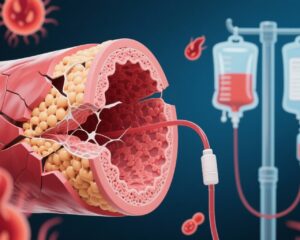Study background and disease burden
Chronic thromboembolic pulmonary hypertension (CTEPH) is a progressive condition characterized by persistent pulmonary vascular obstruction due to organized thromboemboli, leading to elevated pulmonary arterial pressure, increased pulmonary vascular resistance, and right ventricular dysfunction. Inoperable cases, due to distal lesion location or patient comorbidities, pose a therapeutic challenge. Balloon pulmonary angioplasty (BPA) and medical therapy, particularly riociguat—a soluble guanylate cyclase stimulator—are established treatments; however, the benefit of their combined and continued use post-intervention has not been fully elucidated. Exercise intolerance remains a salient clinical problem despite normalized resting hemodynamics after BPA, underscoring the need for strategies to preserve cardiopulmonary function during exertion. The THERAPY-HYBRID-BPA trial addressed this unmet need by evaluating the impact of continuing versus discontinuing riociguat on exercise capacity and safety in patients with inoperable CTEPH who had undergone BPA and achieved normalized resting pulmonary arterial pressures.
Study design
THERAPY-HYBRID-BPA was a multicentre, randomized, double-blind, placebo-controlled, phase 4 trial conducted at four high-volume CTEPH centers in Japan. Eligible patients were adults aged 18 to 85 years with inoperable, World Health Organization functional class II-IV CTEPH, defined by resting mean pulmonary arterial pressure (mPAP) ≥25 mm Hg and pulmonary vascular resistance (PVR) ≥3.0 Wood units confirmed by right heart catheterization. All participants had undergone BPA and riociguat therapy during screening.
Three months following the final BPA, patients achieving a resting cardiac index <5.0 L/min/m2 and mPAP <25 mm Hg were randomized 1:1 to either discontinue riociguat and receive placebo thrice daily for 16 weeks or continue riociguat at the established individualized dose (1.0 mg to 2.5 mg thrice daily) for the same duration. Randomization used a block size of 8, stratified by center and riociguat dose, with patients and investigators masked to treatment assignment.
The primary endpoint was the change in peak cardiac index during cardiopulmonary exercise testing (CPET) from baseline to week 16, measured by the direct Fick method, analyzed in the full analysis set excluding patients with consent withdrawal, protocol violations, or without drug exposure. Safety was evaluated in all patients receiving at least one dose.
Key findings
Between November 25, 2020, and May 16, 2023, 74 patients (58 females and 16 males) were randomized: 36 to the riociguat-discontinuing group and 38 to the riociguat-continuing group. Primary analysis included 32 and 34 patients from each group after excluding those with missing data.
The adjusted mean peak cardiac index during CPET decreased significantly in the riociguat-discontinuing group by -1.11 L/min/m2 (95% CI -2.14 to -0.09) versus a negligible decrease of -0.03 L/min/m2 (95% CI -1.04 to 0.99) in the riociguat-continuing group over 16 weeks. The intergroup difference was 1.09 L/min/m2 (95% CI 0.20-1.97; p=0.017), favoring continued riociguat therapy for preservation of exercise cardiac output.
Adverse events were non-serious and occurred in 28% of the discontinuing group compared to 38% in the continuing group (p=0.36), with no treatment-related deaths reported. These results indicate continued riociguat does not increase adverse event risk but confers protective effects on exercise tolerance post-BPA.
Expert commentary
The THERAPY-HYBRID-BPA trial provides robust randomized evidence supporting the clinical benefit of maintaining riociguat therapy after normalization of resting pulmonary hemodynamics via BPA in inoperable CTEPH patients. The preservation of exercise cardiac index suggests sustained pulmonary vasodilatory effects of riociguat under stress conditions, potentially preventing microvascular remodeling or dysfunction that may not be captured at rest.
While resting hemodynamic normalization post-BPA is an important milestone, exercise intolerance remains a limiting factor for patient quality of life. This study elegantly demonstrates that discontinuation of riociguat post-BPA is associated with deterioration in exercise capacity, highlighting the importance of dynamic assessments in CTEPH management.
Limitations include the relatively short 16-week follow-up and well-selected Japanese patient population; longer-term and more ethnically diverse studies are warranted to confirm durability and generalizability. Despite the relatively small sample size, the statistically significant and clinically meaningful difference in cardiac index underscores a physiologic benefit.
Current international guidelines recognize riociguat as the only approved medical therapy for inoperable CTEPH; however, data on optimal timing and duration relative to BPA remain sparse. This trial fills an important niche, offering evidence to support continued medical therapy adjunctive to interventional treatment.
Conclusion
In patients with inoperable CTEPH who have undergone BPA and achieved normalized resting pulmonary pressures, continuation of riociguat therapy preserves exercise-induced cardiac output without increasing adverse events. Discontinuation of riociguat is associated with significant reduction in peak cardiac index during exercise, indicating worsening exercise intolerance.
These findings reinforce the role of combined modality therapy in CTEPH and advocate for cautious consideration before withdrawing riociguat following BPA. Future long-term studies are required to assess sustained functional benefits, survival outcomes, and potential effects on remodeling to optimize comprehensive CTEPH management strategies.
References
Shimokawahara H, Nishizaki M, Inami T, et al. Effect of riociguat on exercise following balloon pulmonary angioplasty in patients with inoperable chronic thromboembolic pulmonary hypertension in Japan (THERAPY-HYBRID-BPA): a multicentre, double-blind, randomised, controlled, phase 4 trial. Lancet Respir Med. 2025 Sep;13(9):789-799. doi:10.1016/S2213-2600(25)00127-4. PMID: 40714010.
Ghofrani HA, D’Armini AM, Grimminger F, et al. Riociguat for the treatment of chronic thromboembolic pulmonary hypertension. N Engl J Med. 2013;369(4):319-329.
Pepke-Zaba J, Delcroix M, Lang I, et al. Chronic thromboembolic pulmonary hypertension (CTEPH): results from an international prospective registry. Circulation. 2011;124(18):1973-1981.
Miyamoto S, Nagaya N, Satoh T, et al. Balloon pulmonary angioplasty for inoperable patients with chronic thromboembolic pulmonary hypertension. Circ Cardiovasc Interv. 2012;5(6):756-762.

